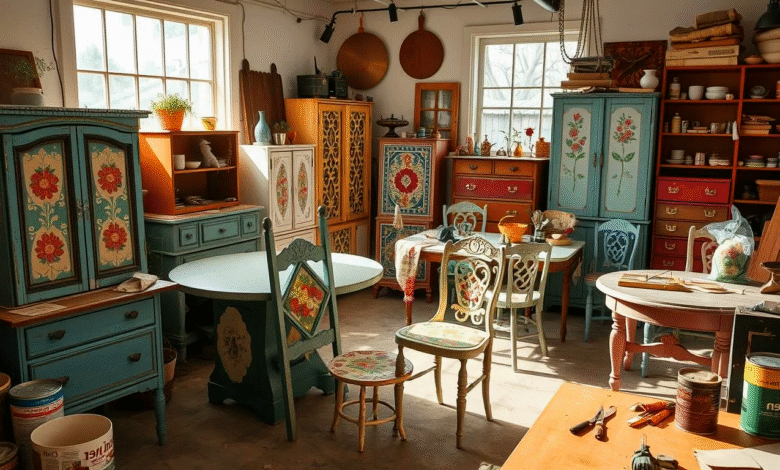Upcycle Old Furniture with These Easy DIY Techniques
In this comprehensive guide, we’ll explore easy DIY techniques to upcycle old furniture, offering step-by-step instructions, creative ideas and tips.

Upcycling old furniture is a fantastic way to breathe new life into pieces that might otherwise end up in a landfill. Not only does it save money, but it also allows you to create unique, personalized home decor that reflects your style. Whether you’re a seasoned DIY enthusiast or a beginner looking to try something new, upcycling old furniture is an accessible and rewarding project. In this comprehensive guide, we’ll explore easy DIY techniques to upcycle old furniture, offering step-by-step instructions, creative ideas, and tips to ensure your projects are both beautiful and sustainable. With the right tools and a bit of creativity, you can transform outdated or worn-out pieces into stunning additions to your home.
Why Upcycle Old Furniture?
Upcycling old furniture is more than just a trendy hobby—it’s an environmentally friendly practice that reduces waste and promotes sustainability. By repurposing items like old chairs, tables, or dressers, you’re giving them a second chance while minimizing your ecological footprint. Here are some compelling reasons to upcycle old furniture:
- Sustainability: Upcycling reduces the demand for new furniture, conserving natural resources and reducing waste.
- Cost-Effective: Instead of purchasing expensive new pieces, upcycling allows you to revamp existing furniture for a fraction of the cost.
- Personalization: Upcycled furniture reflects your unique style, making your home decor one-of-a-kind.
- Creative Outlet: Upcycling old furniture is a fun and rewarding way to express your creativity.
Whether you’re looking to refresh a thrift store find or give a family heirloom a modern twist, upcycling old furniture offers endless possibilities.
Essential Tools and Materials for Upcycling Furniture
Before diving into specific techniques, it’s important to gather the right tools and materials. Having the proper supplies ensures your upcycling projects go smoothly and yield professional-looking results. Here’s a list of essentials for upcycling old furniture:
- Sandpaper or Sander: Smooths surfaces for painting or staining.
- Primer and Paint: Provides a fresh base and color for your furniture.
- Paintbrushes and Rollers: For precise and even application.
- Screwdrivers and Wrenches: For disassembling and reassembling furniture.
- Cleaning Supplies: Degreasers, soap, and water to clean surfaces before starting.
- Protective Gear: Gloves, masks, and goggles for safety.
- Decorative Elements: Knobs, handles, stencils, or decoupage paper for customization.
- Sealant: Polyurethane or wax to protect your finished piece.
With these tools in hand, you’re ready to start transforming your furniture. Let’s explore some easy DIY techniques to upcycle old furniture.
Technique 1: Painting for a Fresh Look
One of the simplest and most effective ways to upcycle old furniture is by giving it a fresh coat of paint. Painting can completely transform the look of a piece, whether it’s a dated dresser, a worn-out table, or a set of chairs. Here’s how to do it:
Step-by-Step Guide to Painting Furniture
- Clean the Surface: Start by thoroughly cleaning the furniture to remove dirt, grease, or grime. Use a mild detergent and water, then let it dry completely.
- Sand the Surface: Lightly sand the furniture to create a smooth surface for the paint to adhere to. For glossy finishes, use medium-grit sandpaper (120-150 grit).
- Apply Primer: Use a high-quality primer to ensure the paint sticks properly, especially on slick surfaces like laminate or varnished wood.
- Choose Your Paint: Opt for chalk paint, latex paint, or spray paint, depending on the finish you want. Chalk paint is popular for upcycling old furniture because it requires minimal prep and gives a matte, vintage look.
- Paint the Furniture: Apply thin, even coats of paint, allowing each coat to dry before adding another. Two to three coats are usually sufficient.
- Seal the Finish: Protect your work with a clear sealant like polyurethane or wax to prevent chipping and wear.
Creative Painting Ideas
- Two-Tone Effect: Paint the body of a dresser one color and the drawers another for a modern contrast.
- Distressed Look: After painting, lightly sand edges and corners to create a rustic, shabby-chic vibe.
- Ombre Design: Blend multiple shades of the same color for a gradient effect on shelves or tabletops.
Painting is a versatile technique that allows you to upcycle old furniture into pieces that match your home’s aesthetic, whether it’s modern, farmhouse, or bohemian.
Technique 2: Decoupage for Artistic Flair
Decoupage is a fantastic way to add patterns, textures, or images to your furniture. This technique involves adhering paper or fabric to a surface and sealing it with a clear coat. It’s perfect for adding a unique, artistic touch when you upcycle old furniture.
How to Decoupage Furniture
- Choose Your Material: Select decorative paper, wrapping paper, or fabric with patterns that complement your decor. Floral designs, geometric patterns, or vintage maps work well.
- Prepare the Surface: Clean and sand the furniture to ensure a smooth base.
- Cut and Arrange: Cut your paper or fabric to fit the surface, such as drawer fronts or tabletops. Arrange the pieces to create your desired design.
- Apply Adhesive: Use a decoupage glue like Mod Podge to adhere the material to the furniture. Smooth out any bubbles or wrinkles.
- Seal the Design: Apply multiple layers of decoupage glue or sealant over the paper, allowing each layer to dry. This protects the design and gives it a polished look.
Decoupage Ideas
- Vintage Suitcase Table: Upcycle an old suitcase by decoupaging the top with vintage postcards or travel-themed paper.
- Patterned Dresser Drawers: Add patterned paper to drawer fronts for a pop of color and texture.
- Book Page Tabletop: Use pages from an old book to decoupage a coffee table for a literary-inspired look.
Decoupage is an excellent way to upcycle old furniture with a creative, personalized touch that stands out.
Technique 3: Reupholstering for Comfort and Style
Reupholstering is a great technique to upcycle old furniture like chairs, ottomans, or headboards. By replacing worn-out fabric with fresh, modern material, you can completely change the look and feel of a piece.
Steps to Reupholster Furniture
- Remove Old Fabric: Carefully remove the existing fabric using a staple remover or pliers. Keep the old fabric as a template for cutting new pieces.
- Inspect the Frame: Check for any structural issues, such as loose joints or damaged padding, and repair as needed.
- Cut New Fabric: Use the old fabric as a guide to cut your new material. Choose durable upholstery fabric in a color or pattern that suits your style.
- Attach the Fabric: Secure the new fabric to the furniture using a staple gun, pulling it taut to avoid wrinkles.
- Add Finishing Touches: Trim excess fabric and add decorative elements like piping or studs for a polished look.
Reupholstering Tips
- Choose Durable Fabrics: Opt for materials like cotton, linen, or microfiber that can withstand daily use.
- Experiment with Patterns: Bold prints or textures can make a statement when you upcycle old furniture.
- Add Cushioning: If the padding is worn, replace it with new foam for added comfort.
Reupholstering is a rewarding way to upcycle old furniture, turning outdated pieces into cozy, stylish additions to your home.
Technique 4: Staining or Refinishing Wood
For wooden furniture with beautiful grain or craftsmanship, staining or refinishing is a great way to upcycle old furniture while preserving its natural beauty. This technique enhances the wood’s appearance and protects it from wear.
How to Stain or Refinish Furniture
- Strip the Old Finish: Use a chemical stripper or sandpaper to remove the existing varnish, stain, or paint. Work in a well-ventilated area and wear protective gear.
- Sand the Surface: Smooth the wood with fine-grit sandpaper (220 grit) to prepare it for staining.
- Apply Stain: Choose a wood stain in your desired shade and apply it with a brush or cloth, following the wood grain. Wipe off excess stain for an even finish.
- Seal the Wood: Apply a clear polyurethane or wax sealant to protect the wood and give it a polished look.
Staining Tips
- Test the Stain: Apply a small amount to an inconspicuous area to ensure you like the color.
- Layer for Depth: Apply multiple coats of stain for a richer, darker finish.
- Highlight Details: Use a lighter stain on carved details to make them stand out.
Staining is a classic technique to upcycle old furniture, especially for pieces like dining tables, cabinets, or bookshelves that showcase the beauty of wood.
Technique 5: Repurposing Furniture for New Uses
Sometimes, the best way to upcycle old furniture is to give it an entirely new purpose. Repurposing allows you to think outside the box and create functional, unique pieces for your home.
Creative Repurposing Ideas
- Dresser to TV Stand: Remove a few drawers from an old dresser and use the open space for media equipment, creating a stylish TV stand.
- Ladder to Shelving: Transform an old wooden ladder into a rustic bookshelf by adding planks across the rungs.
- Chair to Planter: Remove the seat of an old chair and use the frame to hold potted plants for a quirky garden feature.
- Door to Headboard: Upcycle an old door into a statement headboard by sanding, painting, or staining it to match your bedroom decor.
Steps for Repurposing
- Assess the Piece: Determine what parts of the furniture can be reused or modified.
- Plan the New Function: Sketch out your idea and measure to ensure it fits the new purpose.
- Modify as Needed: Cut, sand, or paint the furniture to suit its new role.
- Add Finishing Touches: Incorporate hardware, cushions, or other elements to complete the transformation.
Repurposing is a creative and sustainable way to upcycle old furniture, turning forgotten pieces into functional works of art.
Tips for Successful Furniture Upcycling
To ensure your projects are successful, keep these tips in mind when you upcycle old furniture:
- Start Small: If you’re new to upcycling, begin with a simple project like a side table or chair before tackling larger pieces.
- Plan Your Design: Sketch or visualize your project to ensure the colors, patterns, and finishes work together.
- Work in a Well-Ventilated Area: Painting, staining, or using adhesives can produce fumes, so ensure proper ventilation.
- Take Your Time: Rushing can lead to mistakes, so allow ample time for each step, especially drying and curing.
- Source Quality Materials: Invest in good-quality paint, stain, or fabric to achieve a professional finish.
Where to Find Furniture to Upcycle
Finding the right pieces to upcycle old furniture is half the fun. Here are some great places to look:
- Thrift Stores: Affordable furniture with unique character.
- Flea Markets: A treasure trove of vintage pieces waiting to be transformed.
- Garage Sales: Bargain finds from your neighborhood.
- Online Marketplaces: Websites like Craigslist, Facebook Marketplace, or eBay offer a wide selection of used furniture.
- Curbside Pickups: Keep an eye out for free furniture left on the curb, especially in urban areas.
When choosing furniture, look for solid construction and good bones, even if the finish or upholstery is outdated. These pieces are perfect candidates for upcycling.
Eco-Friendly Benefits of Upcycling Furniture
Upcycling old furniture isn’t just about aesthetics—it’s also a sustainable choice. By repurposing furniture, you’re reducing waste, conserving resources, and minimizing the environmental impact of manufacturing new items. According to the Environmental Protection Agency, Americans generate millions of tons of furniture waste annually, much of which ends up in landfills. Upcycling old furniture helps combat this issue by extending the life of existing pieces.
Additionally, upcycling allows you to avoid fast furniture—mass-produced items that are often low-quality and short-lived. By choosing to upcycle old furniture, you’re investing in sustainable home decor that’s both meaningful and environmentally responsible.
Common Mistakes to Avoid When Upcycling Furniture
While upcycling old furniture is relatively straightforward, there are some common pitfalls to avoid:
- Skipping Prep Work: Failing to clean or sand surfaces can result in peeling paint or uneven finishes.
- Using Low-Quality Materials: Cheap paint or adhesives may not last, leading to disappointing results.
- Overloading with Decor: Too many embellishments can make a piece look cluttered rather than stylish.
- Ignoring Safety: Always wear protective gear when sanding, painting, or using chemicals.
By planning carefully and following proper techniques, you can avoid these mistakes and create stunning upcycled furniture.
Inspiration for Your Next Upcycling Project
Need some inspiration to get started? Here are a few ideas to spark your creativity when you upcycle old furniture:
- Mid-Century Modern Makeover: Paint a vintage dresser in a bold color like mustard yellow and add sleek, minimalist knobs.
- Farmhouse Charm: Distress a wooden table and finish it with a whitewash stain for a rustic look.
- Boho Vibes: Reupholster a chair with a colorful, patterned fabric and add decorative studs for a bohemian flair.
- Industrial Edge: Upcycle an old metal filing cabinet with a matte black finish and new leather pulls.
The possibilities are endless when you upcycle old furniture, allowing you to create pieces that are as unique as you are.
Conclusion
Upcycling old furniture is a rewarding and sustainable way to refresh your home decor while expressing your creativity. Whether you’re painting a dresser, decoupaging a table, reupholstering a chair, staining a cabinet, or repurposing a door, these easy DIY techniques make it simple to transform outdated pieces into stunning focal points. By choosing to upcycle old furniture, you’re not only saving money but also contributing to a more sustainable future. So, grab your tools, unleash your imagination, and start upcycling old furniture today—your home (and the planet) will thank you!











